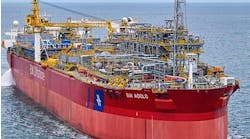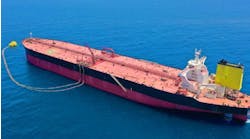Adrian John, Steve Robertson - Douglas-Westwood Ltd.
Strong growth in spending on new LNG plants, vessels, and terminals is forecast by Douglas-Westwood Ltd. (DWL) in its soon to be released third edition of “The World LNG & GTL Report.”
The LNG business has grown substantially in recent years with the completion of some high-profile projects. While demand remains strong in the traditional Asian markets, much attention now is being directed to opportunities in the potentially vast Atlantic basin LNG market. Meanwhile, the limits of domestic gas production in North America and Western Europe are becoming clear and gas import demands are rising. Increasingly, LNG is a method of choice to satisfy growing gas demand. Following success of plants recently established in Equatorial Guinea, Nigeria, and Trinidad & Tobago, a wave of new projects has emerged that demonstrate the potential for serious market growth over the next five years. However, despite strong demand-side fundamentals, supply-side constraints impact the business – EPC costs are rising, final investment decisions are being delayed or postponed as a result. While major growth is still in prospect, the timing of operators’ planned expenditure is likely to move significantly “to the right.”
Development of LNG
The last five years have seen a 46% increase in global LNG liquefaction capacity, from 129 million tons per year in 2002 to 188 million tons per year in 2006. A number of factors drive this growth, including:
- Continuing growth in world gas consumption – The Energy Information Administration of the US Department of Energy (EIA) forecasts gas consumption to grow at an annual rate of 2.4% to 2030, compared to 1.4% for oil and 2.5% for coal. Gas will account for 26% of global energy by 2030
- Strong import demand – Many major gas-consuming nations have either very little gas production of their own (e.g. Japan, South Korea) or have developed and drawn down their own reserves to the point where they are past peak production and will have to rely on imported gas (e.g. US, UK)
- Monetization of stranded gas reserves – Significant amounts of natural gas reserves are a long distance from the consumer or have no nearby pipeline infrastructure. Without access to markets, the produced gas is either flared or re-injected. LNG offers an access mechanism, a method to monetize these gas reserves and to reduce the environmental impact that is associated with gas flaring
- Technological advances – Advances in liquefaction technology had led until recently to a fall in the level of capital expenditure (capex) required to construct new plants. Nonetheless, the development of larger liquefaction trains will create larger economies of scale to compensate somewhat for rising capex requirements and to sustain the economic viability of LNG.
Gas liquefaction technology has its roots in the 19th century, pioneered by individuals such as Michael Faraday and Karl Von Linde. However, the worldwide LNG trade began in earnest in the 1960s when, following a number of test shipments across the Atlantic to prove the concept, the first commercial LNG trade began between Algeria and the UK. Although the UK may have led the way in adopting LNG technology, the region in which the LNG business really took off was Asia. Japan, which had no gas production of its own, was very quick to adopt the new technology, and soon was followed by South Korea and Taiwan. Meanwhile, in Western Europe the technology also was adopted to a much lesser extent to import gas from Africa.
LNG carriers
There currently are more than 230 LNG tankers in operation. Only a few shipyards can build LNG tankers due to the complexity of the vessels and the high levels of quality control required. LNG tankers by far are the most expensive type of cargo vessel, costing two to three times the price of an oil tanker of similar tonnage.
In the past, it has been normal for vessels to be dedicated to particular projects on long-term contracts, but spot trading is increasingly significant and now is thought to account for around 13% of total LNG trade.
The main types of vessel designs are in use -- the Kvaerner-Moss Spherical System, the Gaz Transport Technigaz membrane type, and IHI’s Structural Prismatic design. The membrane system is the most widely adopted. It is used in over half of the LNG vessels in service as of 2007, and will be used in around 85% of the vessels scheduled for delivery during 2007-2010. The Moss system is used in 45% of LNG vessels in service as of 2006, and will be used in over 10% of the vessels scheduled for delivery during 2007-2010.
Trends and forecasts
The capital expenditure graph shows the levels of spending that DWL forecasts will be required to complete new LNG facilities over the 2007-2011 period. The dates refer to the year of start-up for the terminal. In practice, however, the contractual payments relating to the projects often are made in installments and most likely will be spread over a number of years and not confined to a single year. For clarity and transparency, DWL does not to try to reflect this in its forecasts, preferring to indicate the value of the new LNG facilities that come into use each year.
The trend is one of strong market growth, with global capex on LNG developments over the 2007-2011 period expected to exceed $110 billion – almost three times the amount spent over the previous five-years.
Over the 2002-2006 period, data indicates that 65.8 million tons per year of liquefaction capacity was brought on stream by new LNG export plants and that the capex associated with these plants (excluding upstream costs but including all terminal costs: plant, storage, marine facilities, etc.) totaled $16.5 billion.
For 2007-2011, new liquefaction facilities coming on stream will lead to a massive increase in global LNG output capacity, requiring capex of almost $42 billion. Two regions - Africa and the Middle East - will see dramatic growth in expenditure and together will account for 64.5% of forecast capex and almost 96 million tons per year of additional liquefaction capacity.
In Africa, key developments will include further development of BG’s facility at Idku, along with the Bioko Island plant in Equatorial Guinea and continuing expansion of the Nigerian LNG plant at Bonny Island. In the Middle East, the RasGas and Qatargas developments in Qatar will take center-stage.
Importantly, EPC cost escalation has postponed many liquefaction projects. Until around 2005, technological advances, increased economies of scale, and increased competition between licensors, contractors, and suppliers within the LNG liquefaction industry had driven the costs down to below $200 per ton of annual capacity. However, escalating costs of labor and raw materials, and the tight contractor market have led to increases in new EPC contract costs. By 2009, many projects coming on-stream will have EPC costs of at or above $300 per ton of annual capacity.
Activity in the newbuild LNG carrier market is dominated by Asia. Over the next five years, DWL anticipates that more than 195 new carriers will be constructed. Capex for this is forecast to be near $42 billion.
Analysis of DWL data indicates the average price of LNG vessels delivered over the previous five-year period fell to as low as $162 million in 2002. This drop was due largely to competition among shipyards in the Far East, Korean in particular. However, while the market is expected to remain competitive (with the entrance of Chinese yards into the market being a point of interest) shipping demand is at an all-time high with lead times for newbuilds out to five years. Newbuild prices now exceed $200 million again, with the trend towards increasingly larger vessels expected to continue. •
Endnote
Douglas-Westwood Ltd. is a leading provider of business research and strategy services in the international energy and marine industries. For further information about The World LNG & GTL Report, please visitwww.DWL-1.com, e-mail [email protected], or call +44 (0)1227 780999.
Authors
Adrian John is an analyst with DWLL and lead author of the ‘World LNG & GTL Report 2007’. John has conducted market analysis for a variety of DWL’s clients in the oil and gas sector as part of commissioned research, commercial due-diligence, and published market studies. John has a background in the engineering and construction industry and graduated with honors in engineering from Cambridge.
Steve Robertson is assistant director and manager of Oil & Gas at DWLL. He has authored a number of “The World…” series of market reports including ‘The World LNG & GTL Report’ and is editor of the latest edition. Within the LNG sector, Robertson has led DWL’s work for a variety of commissioned engagements ranging from small technology players to major oil companies. In the wider oil and gas sector, his analysis has included all facets of LNG, oil & gas field development, the subsea production sector, floating production, MMO, etc. Robertson has managed market due-diligence studies on deals totaling $2.2 billion in 2006 working for investment banks and PE houses, both in the UK and abroad.






